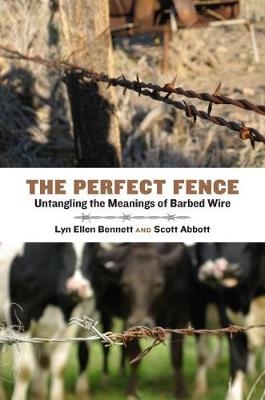
The Perfect Fence
Untangling the Meanings of Barbed Wire
Seiten
2018
Texas A & M University Press (Verlag)
978-1-62349-582-4 (ISBN)
Texas A & M University Press (Verlag)
978-1-62349-582-4 (ISBN)
- Titel z.Zt. nicht lieferbar
- Versandkostenfrei
- Auch auf Rechnung
- Artikel merken
Barbed wire is made of two strands of galvanized steel wire twisted together for strength and to hold sharp barbs in place. In The Perfect Fence, Lyn Ellen Bennett and Scott Abbott explore the multiple uses and meanings of barbed wire, a technological innovation that contributes to America's shift from a pastoral ideal to an industrial one.
Barbed wire is made of two strands of galvanized steel wire twisted together for strength and to hold sharp barbs in place. As creative advertisers sought ways to make an inherently dangerous product attractive to customers concerned about the welfare of their livestock, and as barbed wire became commonplace on battlefields and in concentration camps, the fence accrued a fascinating and troubling range of meanings beyond the material facts of its construction.
In The Perfect Fence, Lyn Ellen Bennett and Scott Abbott explore the multiple uses and meanings of barbed wire, a technological innovation that contributes to America’s shift from a pastoral ideal to an industrial one. They survey the vigorous public debate over the benign or “infernal” fence, investigate legislative attempts to ban or regulate wire fences as a result of public outcry, and demonstrate how the industry responded to ameliorate the image of its barbed product.
Because of the rich metaphorical possibilities suggested by a fence that controls through pain, barbed wire developed into an important motif in works of literature from the late nineteenth century to the present day.
Early advertisements proclaimed that barbed wire was “the perfect fence,” keeping “the ins from being outs, and the outs from being ins.” Bennett and Abbott conclude that while barbed wire is not the perfect fence touted by manufacturers, it is indeed a meaningful thing that continues to influence American identities.
Barbed wire is made of two strands of galvanized steel wire twisted together for strength and to hold sharp barbs in place. As creative advertisers sought ways to make an inherently dangerous product attractive to customers concerned about the welfare of their livestock, and as barbed wire became commonplace on battlefields and in concentration camps, the fence accrued a fascinating and troubling range of meanings beyond the material facts of its construction.
In The Perfect Fence, Lyn Ellen Bennett and Scott Abbott explore the multiple uses and meanings of barbed wire, a technological innovation that contributes to America’s shift from a pastoral ideal to an industrial one. They survey the vigorous public debate over the benign or “infernal” fence, investigate legislative attempts to ban or regulate wire fences as a result of public outcry, and demonstrate how the industry responded to ameliorate the image of its barbed product.
Because of the rich metaphorical possibilities suggested by a fence that controls through pain, barbed wire developed into an important motif in works of literature from the late nineteenth century to the present day.
Early advertisements proclaimed that barbed wire was “the perfect fence,” keeping “the ins from being outs, and the outs from being ins.” Bennett and Abbott conclude that while barbed wire is not the perfect fence touted by manufacturers, it is indeed a meaningful thing that continues to influence American identities.
Lyn Ellen Bennett is professor of history at Utah Valley University in Orem, Utah. Her research focuses on the American West, gender, and material culture studies. Scott Abbott is professor of humanities, philosophy, and integrated studies at Utah Valley University. He is the author of five books, most recently, Immortal for Quite Some Time: Fraternal Meditations.
| Erscheinungsdatum | 01.02.2018 |
|---|---|
| Reihe/Serie | Connecting the Greater West Series |
| Zusatzinfo | 42 black & white photographs, 2 figures, table |
| Verlagsort | College Station |
| Sprache | englisch |
| Maße | 156 x 235 mm |
| Themenwelt | Sachbuch/Ratgeber ► Geschichte / Politik ► Allgemeines / Lexika |
| Geisteswissenschaften ► Geschichte ► Regional- / Ländergeschichte | |
| Geschichte ► Teilgebiete der Geschichte ► Technikgeschichte | |
| Geschichte ► Teilgebiete der Geschichte ► Wirtschaftsgeschichte | |
| Geisteswissenschaften ► Sprach- / Literaturwissenschaft ► Anglistik / Amerikanistik | |
| Technik | |
| ISBN-10 | 1-62349-582-2 / 1623495822 |
| ISBN-13 | 978-1-62349-582-4 / 9781623495824 |
| Zustand | Neuware |
| Haben Sie eine Frage zum Produkt? |
Mehr entdecken
aus dem Bereich
aus dem Bereich
Buch | Softcover (2024)
Lehmanns Media (Verlag)
CHF 27,90
Digitalisierung neu denken für eine gerechte Gesellschaft
Buch | Hardcover (2023)
Quadriga (Verlag)
CHF 27,95
Vom Perceptron zum Deep Learning
Buch | Softcover (2022)
Springer Vieweg (Verlag)
CHF 27,95


